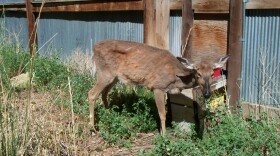A case of chronic wasting disease — also called CWD — has been confirmed in a deer in Ogemaw County. It is the northernmost confirmed case of the disease so far in the Lower Peninsula.
CWD infects animals in the deer family, including moose and elk, though there have been no confirmed cases in moose or elk in Michigan.
CWD is not caused by bacteria or a virus, but abnormal proteins called prions. They cause the brain to deteriorate in a "spongy manner," according to the Michigan Department of Natural Resources (DNR). Infected deer may lose weight, seem disoriented, walk in circles, drool, and lose their natural caution of humans; the DNR says they die within 18 to 24 months.
Although there are no known cases of CWD infecting humans, agencies such as the Center for Disease Control and Prevention discourage people from eating the meat of infected deer.
Chad Stewart is the deer, elk, and moose management specialist for the DNR. He said managing the disease is complicated because it can often be hard to know if an animal is infected.
"Once an animal is infected, it takes a while for it to show outward symptoms ... but the animal can still transmit the disease. It can stay in the environment and go a long time without being detected. By the time you actually detect CWD, it can be fairly widespread. Unfortunately, the only way to test for CWD is a post-mortem test," Stewart explained.
The DNR rotates testing sites for CWD in various counties annually. Hunters can also have their harvested deer tested. This year's testing is focused on the northwest region of the Lower Peninsula. One county — Isabella — had a deer test positive for CWD. So far, CWD has been detected in 13 counties in Michigan: Clinton, Dickinson, Eaton, Gratiot, Hillsdale, Ingham, Ionia, Isabella, Jackson, Kent, Midland, Montcalm, and, most recently, Ogemaw.
Stewart is optimistic that, with proper herd management, CWD can also be managed.
"I do think that we can live with chronic wasting disease. I think there's a responsibility to manage our overall deer herd and keep numbers a little bit lower. Certainly still a huntable population, still an abundant population ... but not quite as abundant as what we currently have."






